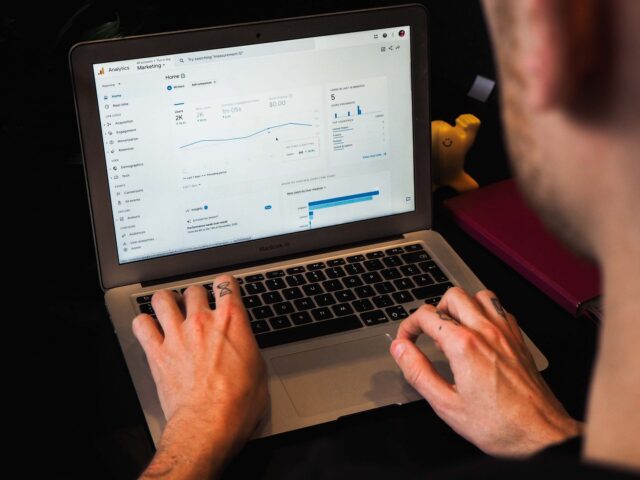Demographic data is a lot more valuable than you might think. It can help shape your website, paid campaigns, and even your overall business model. Plus, it’s readily available.
GA4 demographics
By identifying the overall behaviour of different demographic groups based on age, gender and interests, you can tailor your website and any online or offline advertising towards them.
How much demographic information is available on Google Analytics 4?
Google Analytics 4 has a wealth of free information about the different demographics visiting your website.
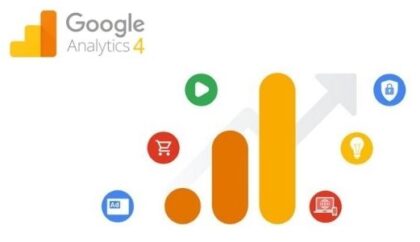
Demographic data is collected from users who are logged into a Google account (Gmail or YouTube for example), from third-party cookies, or from smartphone ad tracking.
Google accounts require preset personal information – such as age and gender – to be entered when users make an account. Google can also make accurate guesses at ages or genders by analysing any search terms used, video watched, or websites visited via third-party cookies (or possibly via The Privacy Sandbox initiative in 2024).
When you visit a website with Google tracking enabled, your demographic information can be passed on to Google Analytics for the account owner to see a summary of all the demographic information of visitors. This summary is only shown if there are enough visitors in each group to avoid any privacy issues that may occur if the data is too granular.
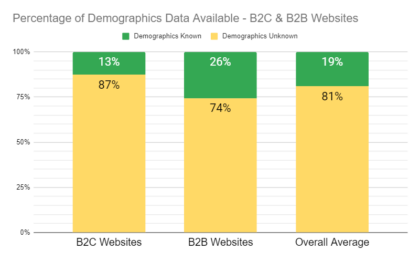
GA4 demographics
By identifying the overall behaviour of different demographic groups based on age, gender and interests, you can tailor your website and any online or offline advertising towards them.
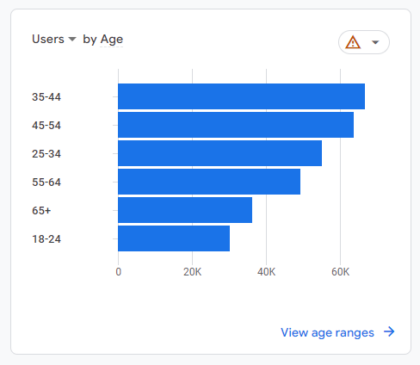
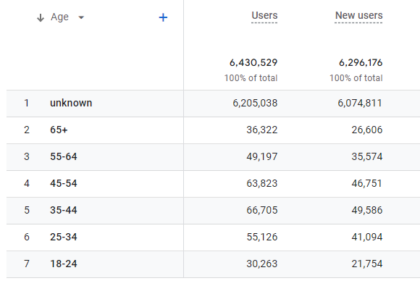 Note that those under 18 are not part of the age demographic report for legal and ethical reasons.
Note that those under 18 are not part of the age demographic report for legal and ethical reasons.
Gender
The genders reported are male, female and unknown:

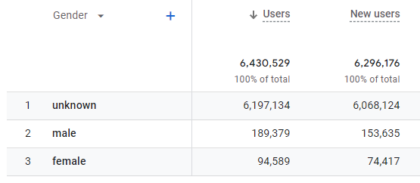
Interests
Interests are the most interesting (sorry, not sorry) pieces of data you can find within the “Audience” section of Google Analytics. Google uses an array of data taken from Gmail, app messages, internet browsing habits and YouTube videos watched to make an accurate guess of each user’s personal interests.
There are three different types of interests you can view:
- Affinity categories – People who are labelled as part of a collective. For example, people who like to travel, play sports, or use their smartphones a lot.
- In-market segments – People who are actively in-market to buy something at the moment. Perhaps someone looking to purchase a holiday, a new bicycle, or to move home.
- Other categories – This is a more in-depth look at affinity categories, highlighting people who might fly a lot, play a lot of video games, or people who like gardening etc.
Geolocation
Google Analytics 4 now classes the geolocation report as part of the demographics section where you break down users into different countries, regions, and towns/cities:
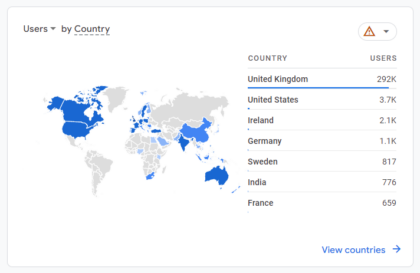
Language
Every language is shown within the language report, which is very important for multi-language countries:
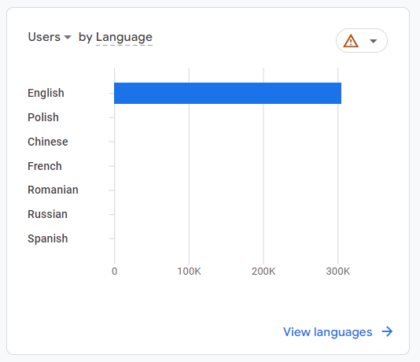
How to view age, gender or interests metrics in GA4
The easiest way to view demographic data is by going into the report section of GA4 and selecting [User > Demographics].
If there is no information here then it means that you haven’t enabled Google Signals on your GA4 account – this is what allows Google to collect the information and build up audiences.
To find the Google Signals setting, go to the settings cog in the bottom left-hand corner and navigate to [Data Settings > Data Collection]:
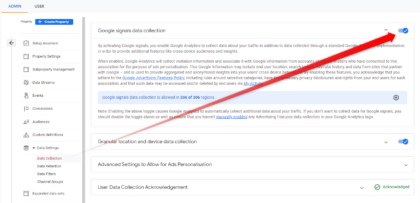
Data will now be added to the GA4 account – but only after when Google Signals was enabled and can take up to two days to pull through.
On each card, you can dig into one demographic dimension by clicking the link in the bottom-right corner:
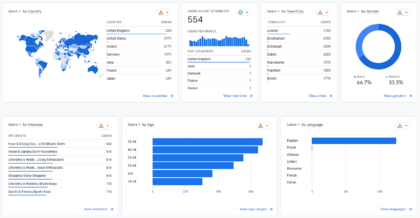 The information provided in each demographic report will give a detailed breakdown of all the data available. Please note that the results may only show the previous few months of data, and not the entire lifetime of the GA4 account:
The information provided in each demographic report will give a detailed breakdown of all the data available. Please note that the results may only show the previous few months of data, and not the entire lifetime of the GA4 account:

This data can be downloaded as a CSV spreadsheet file which allows you to create custom graphs and charts:
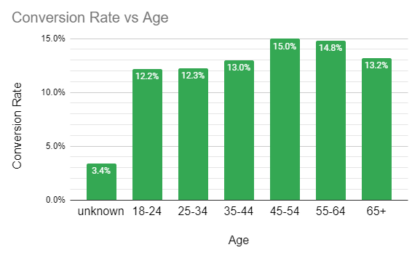
Combing demographic data with secondary dimensions
When viewing one of the detailed demographic reports, you can add a secondary dimension to the chart to segment the data further and gain deeper insights about your users.
Click the small blue plus icon to add a secondary dimension:
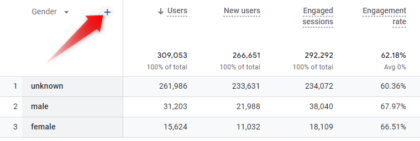
There are many choices of secondary dimensions to choose from, such as the user source, geo-location, or time of day:
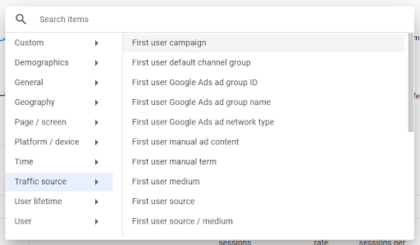
Exporting this data into a spreadsheet app (such as Google Sheets) allows you to visually see which age and gender groups convert best and worst. For example:
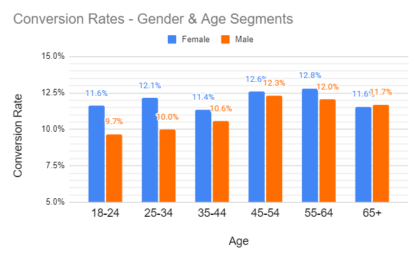
What to do with this demographic information?
You’ve likely spotted that a demographic segment of your users perform differently from your other website visitors. You may have a majority of users from a certain city, a certain gender, or a certain age, which gives you a demographic majority:
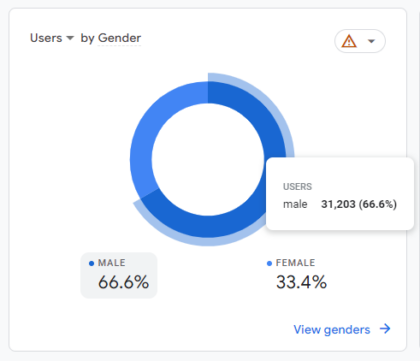
This paints a picture about the average user on your website and should influence the key messaging on the website, your social media, and your ads.
The best metrics to look at in GA4 for this are: average engagement rate, conversions/users, and revenue if applicable.
There are two routes businesses can go down with demographic breakdowns, they can either be a generic business for all types of demographics, such as a shop selling sofas, or a highly targeted niche business, such as a dating website for people over 50.
When it comes to advertising, you can either target, or weigh ads towards specific demographics, even if the website is a generic one for all walks of life. This allows you to create super-focused ads for a specific demographic, for example, we could target 25-34 year old females in London only.
Looking at your own website’s demographics may spur you to focus your business solely on a certain demographic which would certainly increase the conversion rate of users, and allow all branded material to be focused upon that one segment:
 Beard only dating app anyone?
Beard only dating app anyone?
Failing demographics
When comparing different demographics, if there are significant differences in important metrics such as conversion rates, then you can try and address the issue by thinking about why a certain group isn’t performing.
Examples of differences we typically see on websites include:
- Younger generations not buying higher-priced items as older generations
- Males converting less on products without technical information
- Older generations prefer to make payments over the phone
- A higher percentage of women buying products for men than vice-versa
- Hyper local geographic performance on ecommerce websites that also have a local store
When you spot an underperforming demographic, you may wish to create a persona for an imaginary person within that demographic, then think about why they may be put off by the offer available to them and what sort of situation they are currently in. Perhaps the person is in a rush, has a limited amount of money to spend, is worried about their data protection, has bad eyesight, etc. and this is one of the hurdles that stop them from ultimately converting.

Certain demographics will prefer to make big purchases over the phone.
Other places to get demographic data online
Most social networks give you demographical data about people you’re connected with, although the more precise data is usually behind a paywall such as on LinkedIn.
If you pay for advertising on platforms such as Google Ads or Microsoft Ads then you’ll have access to extra demographic data with internal reports and A.I. driven insights.
YouTube, Twitter, Facebook and other social networks give you some great free information about followers and people who interact with your content. Make sure you check the “analytics” or “insights” section of your most used social, email and paid advertising platforms for some free insights.
There are also many powerful data-driven companies, such as Experian, Oracle, and Nielsen, where you can gain access to very precise information on users to enhance your website – but that’s if you really want to get serious about customer segmentation and have big data sets to analyse.
Conclusion
Demographic data is readily available and should influence how you build your website, how you advertise online and even what your target market should be.
It’s easy to find demographic data in GA4 or social networks, plus you can quickly use it to your advantage when creating campaigns on paid media, emails, or on social platforms.
If you’re willing to pay, then there are some very accurate demographic services to gather information from, or you can unlock demographic data from your paid advertising campaigns.
Want a hand in utilising demographic data? Start a conversation with our data and insights team.




